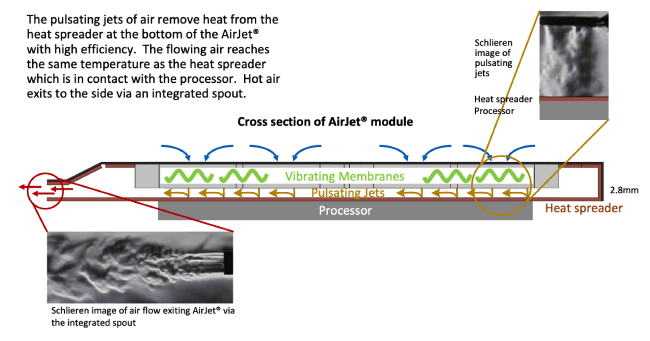Start-up Innovates with MEMS Technology for Portable Device Cooling
In The News | 19-01-2023 | By Robin Mitchell
Removing heat from electronic components is a critical aspect of modern electronics design, but while heatsinks are large and fans are noisy, one start-up believes the future of heat removal lies in their recently developed MEMS (microelectromechanical systems) device. What challenges does heat dissipation present in portable devices, what has the start-up developed, and could this be a viable solution for future devices?
What challenges does heat dissipation present in portable devices?
For as long as electronics have existed, the need for heat removal has always been a challenge faced by engineers. Whether it was the valves used to power radios, the early microprocessors used in the first computers, or the latest GPU found in data centres used to process AI, all electronic devices need to dissipate heat during operation. If this excess heat isn’t removed, component performance can degrade, fail, or worse, break down and catch on fire (something that most engineers have experienced at least once in their life).
One common solution to heat removal is heatsinks, large thermal masses that can pull heat from a component and then dissipate that heat into the surrounding environment. While heatsinks provide engineers with a cheap solution for heat removal, they are often very large, heavy, and have specific position requirements, making them tricky to integrate into portable products that need to be small, light, and able to be oriented in any direction.
Forced air cooling with the use of fans is another option for engineers, and some components can use forced air as their sole means of cooling. However, components that dissipate large amounts of heat can combine a heatsink with a fan (such as desktop computers) which not only helps to pull heat from a device but also provide the needed air cooling to remove that heat from the heatsink. However, fans are loud, power-hungry, and prone to blockage from dust and debris, meaning their use must be carefully considered. While small fans can be made, they are too large for handheld devices, limiting their use in portable devices.
Another option for engineers is liquid-cooling, whereby a liquid is used to extract heat from a device. By far, liquid-cooling provides engineers with the most powerful solution for extracting heat, but the infrastructure needed to make a device liquid-cooled means that only large, stationary systems such as desktop PCs and servers can use it; trying to integrate liquid-cooling on a portable device would be madness.
If none of these options are suitable for a device, the only option left to remove heat is to reduce the capabilities of the device being cooled. For example, mobile processors can reduce their core frequency to reduce heat dissipation which also extends battery life, but at the cost of device performance. Thus, it can be seen that heat dissipation is an equally important factor in device performance, something which massively restricts the portable device industry (such as laptops, smartphones, and smartwatches).
Start-up develops MEMS Technology-powered AirJet cooling
Recognising the challenges faced by traditional heat removal methods, a new start-up called Frore Systems Inc. has unveiled its range of MEMS devices designed to provide active air cooling to portable devices. According to Frore Systems Inc., the new devices, called AirJets, can provide portable devices with twice the processing performance due to their ability to extract significantly more heat compared to current solutions while maintaining a low energy consumption profile.
The technology developed by Frore Systems Inc. takes advantage of small membranes integrated into a MEMS device that vibrates at ultrasonic frequencies to move air. At the same time, a carefully designed U-shape heatsink extracts heat from a connected device (such as a processor) and transfers that heat to the top side of the MEMS device. From there, the pulsating air pressure generated by the vibrating membranes results in cool air being drawn into the device and ejected, taking the thermal energy from the heatsink with it.

What makes the new MEMS device impressive is that not only is it able to draw more thermal energy compared to current solutions, but it only requires approximately 1W of energy to do so while only generating 21dBA of noise (approximately the sound of whispering from a few meters away). Furthermore, the height of the heat sink, approximately 3mm, makes it highly applicable in portable devices where weight and size are heavily restricted. Thus, the new technology can be used to increase the performance of portable processors without facing heating issues.
Could such technologies be viable for future technologies?
MEMS technology is revolutionizing the way heat is dissipated in electronic devices. One of the most promising examples of this is AirJet technology, which is being used in conjunction with major players like Intel and Qualcomm.
The viability of these types of MEMS devices as heat-removal devices has already been proven, and it is expected that they will hit the shelves within a year. While the addition of these heatsinks alone won’t immediately see processor improvements, the low energy profile of these devices allows for other MEMS applications, such as portable devices currently using fans, to switch to AirJet technologies and use the saved energy to increase processor performance without affecting battery life.
Overall, it is exciting to see the introduction of AirJet technologies as it demonstrates the power of MEMS devices, marking a new era in heat dissipation.

